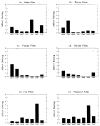Positive Emotions Speed Recovery from the Cardiovascular Sequelae of Negative Emotions
- PMID: 21852890
- PMCID: PMC3156608
- DOI: 10.1080/026999398379718
Positive Emotions Speed Recovery from the Cardiovascular Sequelae of Negative Emotions
Abstract
Two studies tested the hypothesis that certain positive emotions speed recovery from the cardiovascular sequelae of negative emotions. In Study 1, 60 subjects (Ss) viewed an initial fear-eliciting film, and were randomly assigned to view a secondary film that elicited: (a) contentment; (b) amusement; (c) neutrality; or (d) sadness. Compared to Ss who viewed the neutral and sad secondary films, those who viewed the positive films exhibited more rapid returns to pre-film levels of cardiovascular activation. In Study 2, 72 Ss viewed a film known to elicit sadness. Fifty Ss spontaneously smiled at least once while viewing this film. Compared to Ss who did not smile, those who smiled exhibited more rapid returns to pre-film levels of cardiovascular activation. We discuss these findings in terms of emotion theory and possible health-promoting functions of positive emotions.
Figures




Similar articles
-
The Undoing Effect of Positive Emotions.Motiv Emot. 2000 Dec;24(4):237-258. doi: 10.1023/a:1010796329158. Motiv Emot. 2000. PMID: 21731120 Free PMC article.
-
An extended emotion-eliciting film clips set (EGEFILM): assessment of emotion ratings for 104 film clips in a Turkish sample.Behav Res Methods. 2024 Feb;56(2):529-562. doi: 10.3758/s13428-022-02055-4. Epub 2023 Feb 3. Behav Res Methods. 2024. PMID: 36737582 Review.
-
Eliciting emotion ratings for a set of film clips: A preliminary archive for research in emotion.J Soc Psychol. 2020 Nov 1;160(6):768-789. doi: 10.1080/00224545.2020.1758016. Epub 2020 May 18. J Soc Psychol. 2020. PMID: 32419668
-
A New Standardized Emotional Film Database for Asian Culture.Front Psychol. 2017 Nov 3;8:1941. doi: 10.3389/fpsyg.2017.01941. eCollection 2017. Front Psychol. 2017. PMID: 29163312 Free PMC article.
-
The effects of distraction and reappraisal on children's parasympathetic regulation of sadness and fear.J Exp Child Psychol. 2016 Feb;142:344-58. doi: 10.1016/j.jecp.2015.09.020. Epub 2015 Oct 24. J Exp Child Psychol. 2016. PMID: 26601786 Free PMC article. Clinical Trial.
Cited by
-
Promoting positive emotions and instilling concern for the needs of others during the COVID-19 pandemic.PLoS One. 2022 Oct 7;17(10):e0272922. doi: 10.1371/journal.pone.0272922. eCollection 2022. PLoS One. 2022. PMID: 36206517 Free PMC article.
-
Relationship between emotional processing, drinking severity and relapse in adults treated for alcohol dependence in Poland.Alcohol Alcohol. 2015 Mar;50(2):173-9. doi: 10.1093/alcalc/agu099. Epub 2014 Dec 27. Alcohol Alcohol. 2015. PMID: 25543129 Free PMC article.
-
Positive affect and its association with viral control among women with HIV infection.Health Psychol. 2017 Jan;36(1):91-100. doi: 10.1037/hea0000382. Epub 2016 Sep 29. Health Psychol. 2017. PMID: 27685456 Free PMC article.
-
Intangible assets and organizational citizenship behavior: A conceptual model.Heliyon. 2020 Jul 24;6(7):e04497. doi: 10.1016/j.heliyon.2020.e04497. eCollection 2020 Jul. Heliyon. 2020. PMID: 32743100 Free PMC article. Review.
-
Positive Affect in the Midst of Distress: Implications for Role Functioning.J Community Appl Soc Psychol. 2012 Nov;22(6):502-518. doi: 10.1002/casp.1133. J Community Appl Soc Psychol. 2012. PMID: 23175617 Free PMC article.
References
-
- Anderson NB. Racial differences in stress-induced cardiovascular reactivity and hypertension: Current status and substantive issues. Psychological Bulletin. 1989;105:89–105. - PubMed
-
- Anderson NB, McNeilly M, Myers H. A biopsychosocial model of race differences in vascular reactivity. In: Blascovich J, Katkin ES, editors. Cardiovascular reactivity to psychological stress and disease. Washington, DC: American Psychological Association; 1993. pp. 83–108.
-
- Blascovich J, Katkin ES. Cardiovascular reactivity to psychological stress and disease. Washington, DC: American Psychological Association; 1993.
-
- Blumenthal JA. Relaxation therapy, biofeedback and behavioral medicine. Psychotherapy. 1985;22:516–530.
-
- Cabanac M. Physiologic al role of pleasure. Science. 1971;173:1103–1107. - PubMed
Grants and funding
LinkOut - more resources
Full Text Sources
Medical
